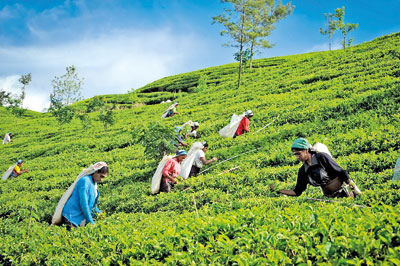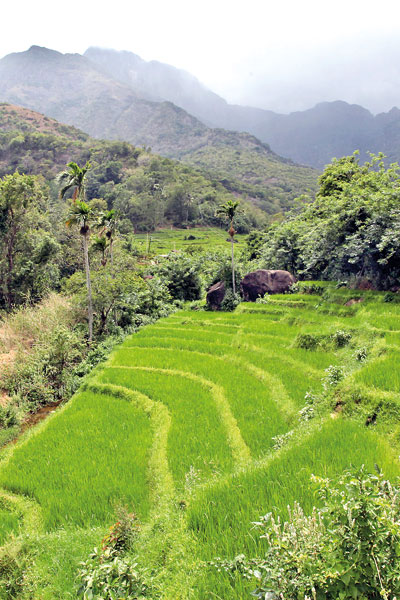View from the top: Election stunts in fertiliser, digital transformation of health
View(s):In a cursory glance of the numerous 2017/18 financial year annual reports of listed companies being released to shareholders this week, the Business Times (BT) takes a look at companies which are involved in plantations, hotels, hospitals, finance and fertilisers. These companies were selected at random based on reports released this week and the BT highlights, briefly, the key challenges in those sectors:

Pluckers on a tea plantation
Nawaloka Hospitals
- Revenue: Rs. 8 billion (2018/17) vs Rs. 6.3 billion (2016/17)
- Post-tax profit: Rs. 179.9 million vs Rs. 241 million (same period as above)
Future of healthcare
Healthcare is one of the fastest advancing sectors today and is facing a transformative period marked by diverging trends, digital technologies, and new biotechnological discoveries. Amidst these global challenges, the healthcare sector must be prepared to face unprecedented demands and embrace innovations to face the future that is already here. The digital healthcare ecosystem has developed at such a rapid pace making digitalisation the foremost trend in healthcare today. Internet access, smartphone penetration, medical technologies such as, artificial intelligence, robotics, genomics, telemedicine, e-consultation and prescriptions, 3D printing of implantable devices and drugs and drone assisted medication delivery will take us to data driven healthcare faster.
Challenges
Artificial Intelligence (AI) will transform the world’s healthcare industry to a new dimension. Digital data generated from medical equipment and software have enhanced understanding about health and diseases and led to the sharing of medical information, remote or peer support, and open access to clinical studies. Data mining is being used to predict disease patterns and trends. In the near future, such AI will replace to some extent reporting of laboratory investigations, radiology investigations, such as, X-rays, and CT and MRI scans.
Care-givers
The population over 60 years of age will have increased to an estimated 2.1 billion by 2050. According to the “Ageing Population in Sri Lanka: Emerging Issues, Needs, and Policy Implications” published by the UNFPA, the process of ageing in Sri Lanka is somewhat rapid since 1980s and the percentage of age 60 years and above had doubled from 6.6 per cent in 1981 to 12.4 per cent in 2012. The current figure is expected to double again to reach 24.8 per cent in 2041. Therefore, the social welfare and health schemes in Sri Lanka should be adequately developed to address the needs of the ageing population of the country.
Central Finance
- Revenue: Rs. 20.4 billion vs Rs. 18 billion
- Post-tax profit: Rs. 5.4 billion vs Rs. 4.7 billion
Unfair
Heavily skewed towards vehicle leasing, the sector’s prospects continue to be affected by the duty revisions taken to curtail the import of vehicles and stricter Loan to Value (LTV) rules to curb lending for motor vehicle purchases, prompting this sector to restructure the core lending model in tandem with market dynamics.
A notable volume decline was seen in the registered and unregistered vehicle market segments consequent to the tightening of LTV rules. CF’s strict adherence, in letter and spirit, to the LTV rules may have resulted in some of the company’s customers moving away to competitors, whose observance of the rules may not have been as stringent as ours. In order that there be a level playing field, it is imperative that there is greater transparency in the manner in which LTV rules are applied by all players in the industry and increased oversight by the regulator.
Nuwara Eliya Hotels Ltd
Revenue: Rs. 917 million vs Rs. 1 billion
Post-tax profit: Rs. 270 million vs Rs. 346 million
Harassment
Recent and past attacks and sexual harassment for tourists are not healthy signs for tourism. Many in the industry were concerned about the news getting the spotlight on social media and if so it’s possible impact on the sector that was just picking up on the numbers. Law and order taking effect could act as a deterrent for these kinds of acts. In this respect, the industry urged the government to ensure that there should be a central defence and tourism apparatus that would lay out clear policies and indicate clear instructions to police in a bid to initiate action in these types of cases.
Durdans Hospitals
- Revenue: Rs. 5.7 billion vs Rs. 4 billion
- Post-tax profit: Rs. 488 million vs Rs. 229 million
Digital transformation
The private health sector is dominated by a few locally owned firms of which we are a part. Private healthcare revenues are expected to record a compound annual growth rate of 8.3 per cent from 2013 to 2020 with revenue reaching US$ 2.1 billion by 2020. The Government’s favourable decision to suspend the 15 per cent Value Added Tax (VAT) with the exception of its residential income and professional charges was welcomed by the industry.

Paddy Cultivation
Expansion within the private sector however is exerting pressure on staffing requirements as doctors work in both public and private sector hospitals. Although doctors have greater flexibility to work within both sectors the same does not hold true for nurses. The lack of standardisation between public and private sector hospitals has also created rigidity within the system. Moreover, public sector hospitals do not recognise the qualifications that nurses obtain from private hospitals. Healthcare operators within the private sector have advised of the lack of qualified medical personnel which currently serves as a key barrier.
The Government is presently attempting to address the issue by streamlining the processes involved in appointing foreign specialists to temporary contracts, a youth training programme for the healthcare sector as well as upgrading training schools for nurses.
Meanwhile digital transformation is expected to revolutionise the healthcare industry while online and mobile platforms are being widely used to engage customers. This has proved to be much more effective than print or broadcast advertising and will only grow more essential in 2018. The patient community no longer wants to be a passive recipient of healthcare services. Instead, they prefer playing an active role throughout the entire treatment cycle.
Behavioural health
Behavioural health issues are gaining more awareness globally. While social stigma surrounding mental health breaks down slowly, healthcare providers are beginning to design systems in such a way that addresses their needs. The reliance of the younger generation on increased use of technology has shown increased rates of anxiety, depression and loneliness. This is also an area requiring a support system that involves trained staff inclusive of psychiatrists, nurses, social workers and clinicians.
Horana Plantations
Revenue: Rs.2.2 billion vs Rs. 2 billon
Post-tax profit: RS. 84.3 million vs (loss) Rs. 41.7 million
Oil palm
It is evident that the plantation industry outlook is ‘change or die.’ In the short term it is definitely all about cost management with another wage increase around the corner and taxes on the agriculture sector increasing from 10 per cent to 14 per cent under the latest tax system, effective from April 2018.
As there is no policy direction on continuing with oil palm expansion, we have decided to expand coconut cultivation instead. We believe there are synergies for coconut within the Hayleys Group itself, and also great revenue growth potential in meeting national demand. The existing oil palm extent will be continued.
Meanwhile a key change will be in the traditional labour model, as this is no longer cost viable. We have already introduced a revenue share model where estate communities will have the opportunity to maintain cultivations on estate lands and that produce will be purchased by the estate. A second change will be integration of technology solutions into traditional agro practices.
We are already looking into the possibility of deploying drones for fertilizing and soil condition checking. We hope to test these plans in 2018.
AgStar Plc
- Revenue: Rs. 3.3 billion vs Rs. 2.8 billion
- Post-tax profit: Rs. 90.3 billion vs Rs. 167.4 billion
Fertiliser
The favourable policy conditions created in 2015 had witnessed an expansion in the fertiliser segment by as much as 70 per cent, however, since then, due to wavering and populist fertiliser policies, the industry has contracted by 0.8 per cent during the year. Our fertilizer volumes grew by 17 per cent while turnover also grew by 18 per cent. Traditionally the fertiliser segment has been a major contributor to group profitability, but on this occasion, profitability of the segment was restricted. Even as the rupee depreciated against the dollar during the year, fertiliser import prices increased, but the company was unable to increase the final selling price due to the ceiling price introduced by the government, thereby, being forced to absorb the cost increase.
Early in the year, the government announced a ceiling on the selling prices for urea, MOP and TSP, which are crucial agri-inputs for farmers. As a result, we had to, on occasion, sell our products well below landed cost. In response, the industry as a whole, reduced import volumes as other players including us were not prepared to bear the loss that would ensue.
Thereafter, in January 2018, in the run up to the election in February, the government announced a fertiliser subsidy for farmers, which resulted in a chunk of our buyers, who are tea and rubber farmers, opting to wait for the subsidised fertiliser from the government. This resulted in a decline in sales of our fertilisers.
As a result, the fourth quarter of the year under review proved to be the worst when it comes to company performance due to the fertiliser uptake being low.
Not long after, the government announced that the private sector can only supply fertiliser to the non-paddy sector and has put a ceiling of 375,000 MT imports per month. This limitation has necessitated that a quota system come into play and naturally quota restricts growth. Since the interest component is borne by the company, if the government delays the subsidy payment to us, the bulk of our margins will be eroded by way of interest on outstanding subsidy. We are hopeful the government will ensure timely payments for the long-term sustainability of the industry.
Unfortunately, the regulator has held on to the given fixed sales price despite fluctuations in the world market prices, currency exchange and tax changes. The lack of a flexible pricing resulted in having to frequently sell below the landed cost price and incurring losses on sale. We are hopeful the regulator will introduce a fair pricing mechanism for the benefit of the state and the industry in future.


